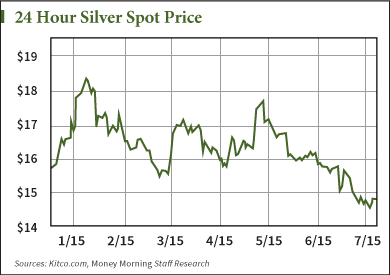 There seems to be a prevailing narrative that investing in silver is only attractive at a time when global central bankers are pursuing easy money policies like low interest rates and quantitative easing.
There seems to be a prevailing narrative that investing in silver is only attractive at a time when global central bankers are pursuing easy money policies like low interest rates and quantitative easing.
So with the U.S. Federal Reserve looking to raise rates some time before the end of the year, investing in silver right now doesn't look like the best idea.
That sentiment has hit the silver price, as the accompanying silver price chart shows. The spot silver price, after having risen as much as 16.7% on Jan. 22, has fallen big time.
Since then, silver prices are down 19.2%, closing out last week at $14.79 per ounce. The silver price per ounce topped out in February 2014 at $21.965. It has fallen 32.7% since then. It's down 69.3% since its April 2011 closing high of $48.70.
So, why would anybody be investing in silver right now?
The obvious answer is that silver investments aren't supposed to be played for explosive gains. They go hand-in-hand with precious metal investments like gold as a way to diversify and provide an asset uncorrelated to the broader market movements.
Silver, like gold, can be looked on as insurance.
"I have physical silver," Money Morning Defense & Tech Specialist Michael A. Robinson said. "I might have bought some at the top, but I don't care what the price goes to; I will not sell that physical silver. It's there for a reason - just like I have insurance on my car, I have insurance in case of a disaster."
But that still falls short of quelling some investor concerns such as, "Why are silver prices falling?"
Especially when for the better part of the last decade, global central bankers haven't shied away from easy money. The conventional wisdom is that with such an "inflationary" bias in central banking, gold should be getting a boost as more money is printed.
The answer to that is a little more complicated.
How an End to Easy Money Makes Investing in Silver Attractive
Surely, for a while, the U.S. Federal Reserve's quantitative easing policy was a huge boost to silver prices.
When QE1 began in November 2008, the price of silver was around $10.50 an ounce. After the end of that program and just months after the beginning of QE2 near the end of 2010, silver prices had shot up to $49.70.
QE propelled silver prices 370%. When the third round of QE kicked off in September 2012, silver prices were trading around $33.50. Since then, they've fallen considerably.
So, what did QE1 and QE2 achieve for silver prices that QE3 couldn't? Not much. Quite honestly, neither round of QE was propping up silver prices.
That's because low rates and accommodative monetary policy aren't "inflationary." QE1 and QE2 came during a time of heightened government spending and lowered expectations for the economy. This was no doubt fueling safe-haven buying. Silver prices began to fall just as Congress was doing battle over cutting the budget.
Government spending puts money directly into the pockets of the consumer. It is inflationary and has the potential to drive up commodity prices.
QE drives up asset prices. It chases investors out of low interest-bearing debt instruments and into the stock market, but it doesn't achieve inflation in the conventional sense.
That's because QE is a measure by which central banks create bank reserves to buy bank assets. When the Fed creates bank reserves, it isn't writing checks directly to consumers. It's simply marking up a bank's checking account. And even that reserve money doesn't find its way into the economy except for when the bank draws down those reserves to buy assets - where we once again get asset inflation.
[epom key="ddec3ef33420ef7c9964a4695c349764" redirect="" sourceid="" imported="false"]
If accommodative monetary policy does anything, it would be deflation. QE lowers rates. Lower rates mean less interest income for savers. And less interest income means less money in the consumer economy.
This makes now, or at least sometime soon, a good time to be investing in silver.
You see, the Fed is teasing a potential interest rate hike before the end of 2015.
When rates go up, more interest rate income will find its way into the economy.
And the kind of inflation that gold and silver bugs were once expecting may begin, if only marginally.
Avoid this gold scam and make sure you own the real deal – this video has seven steps to test your physical gold today:
This silver mining company practically invented the silver "streaming" business... What exactly is silver "streaming?" It's a contract that allows the owner to purchase, in exchange for an upfront payment, all or a portion of the byproduct silver or gold produced by a mine it neither owns nor operates. And it's advantages like these that make this silver mining stock a buy...


